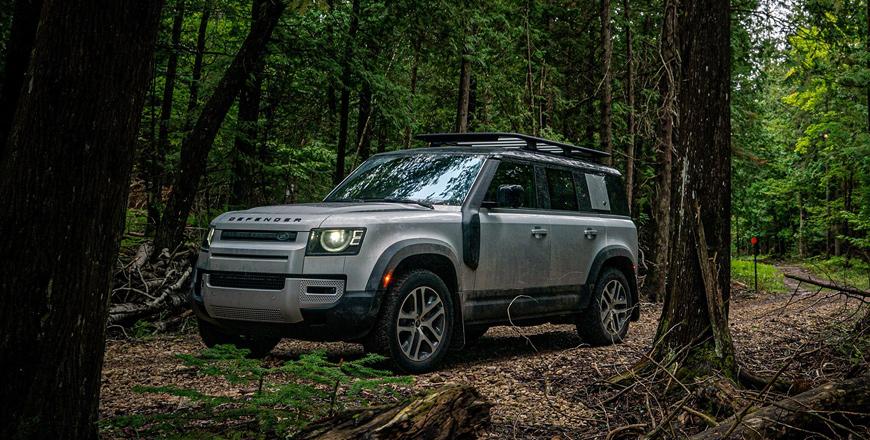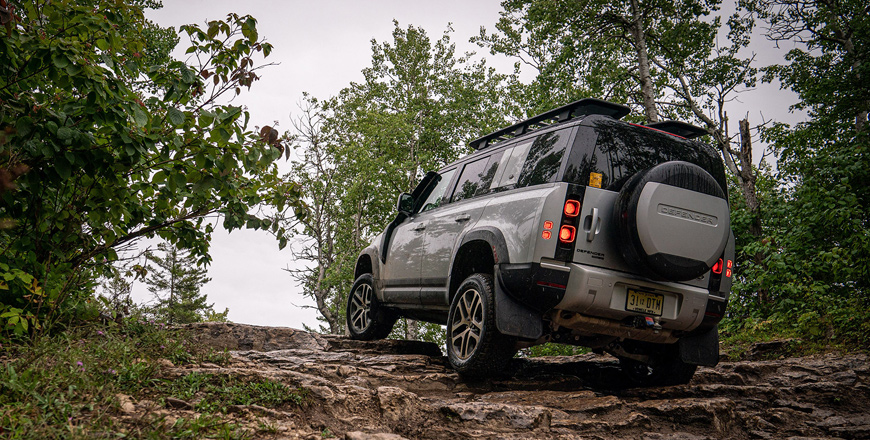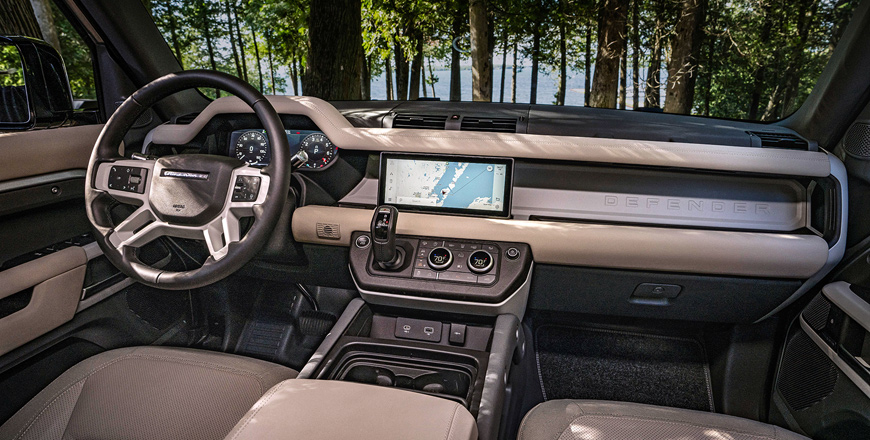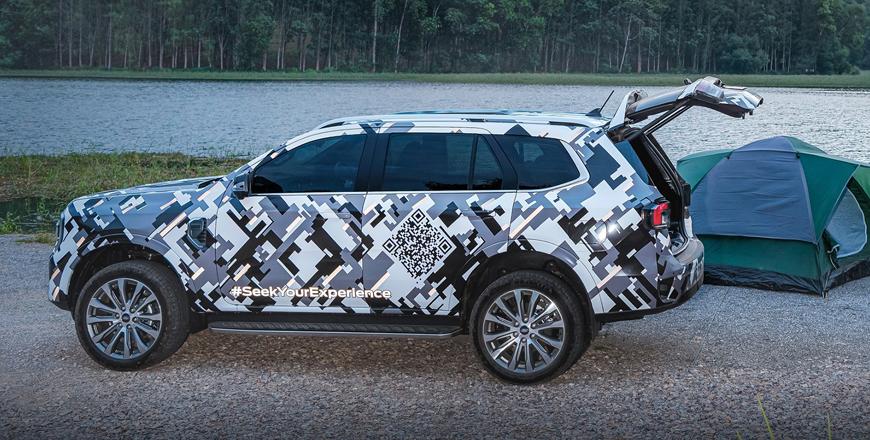You are here
Land Rover Defender 110 P400: Keeping the faith
By Ghaith Madadha - Aug 16,2021 - Last updated at Aug 16,2021

Photos courtesy of Land Rover


Long anticipated since the DC100 concept was unveiled at the 2011 Frankfurt motor show, the new, next generation Land Rover Defender was bound to divide opinion regardless of how good and successful it were, or not.
Successor to the British auto maker’s iconic off-roader, the new Defender is a radical departure from a series of less complicated and more old school predecessors, the first of which the first eponymous model arrived in 1948, and which was followed by progressively slow development over several generations.
Futuristic re-interpretation
A decidedly futuristic yet retro-influenced design built on a monocoque frame and brimming with the latest engine, safety, convenience and infotainment technologies, the new Defender is undoubtedly a much more modern take on Land Rover’s most off-road capable vehicle line. Retaining a high degree of off-road ability, the new Defender has been embraced by many Land Rover customers, but at the same time, hasn’t by other more traditional hardcore fans who prefer the uncomplicated ruggedness of its predecessor.
A decidedly stylised and concept car-like take on the iconic and uncomplicatedly basic Land Rover design with its upright cabin, the modern Defender, however, features flush surfaces, rounded edges and a higher waistline. Its monocoque design allows for improved body rigidity over its predecessor, while it features similarly short overhangs and ground clearance. However, with its monocoque design, bigger alloy wheels, integrated bumpers and lower slung body panels, it is perhaps more susceptible to off-road scrapes and probably more expensive to repair.
Smooth six
Offered either 3-door “90” or 5-door “110” versions, the former short wheelbase model is aesthetically tidier compared to the latter long wheelbase version, which with unchanged short rear overhang seems slightly stretched, similar to 5-door versions of other iconic off-roaders like the Ford Bronco, Jeep Wrangler and Lada Niva. However, both versions have great near equal width to height proportions and excellent off-road clearances, including 38° approach, 40° departure, 28° break-over and 45° side slope and ascent/descent angles for the driven Defender 110
Available with various petrol, diesel and hybrid engines including 4-cylinder and supercharged V8 versions, the driven second-to-top P400 delivers all the power and pulling ability one needs. Powered by a new Jaguar Land Rover developed turbocharged 3-litre in-line 6-cylinder engine, the P400 produces 394BHP 5,500rpm and 406lb/ft throughout a broad 2,000-5,000rpm range. Silky smooth and more refined than Land Rover’s previous supercharged V6 engine, the Defender’s new “straight-six” carries the 2,343kg Defender 110 through 0-100km/h in just 6.1-seconds and onto a 191km/h maximum.
Confident comfort
Responsive from standstill with quick spooling turbo, the Defender is confident and swift off the line and is abundantly versatile throughout a broad and easily accessible mid-range torque-rich sweet spot. Meanwhile, its smooth and naturally-balanced engine is eager to rev to its comparatively low peak power point. The Defender P400 also features a mild hybrid system, which harvests kinetic braking energy to run electric systems, very subtly assist the combustion engine when necessary, and help return comparatively restrained 11.3l/100km combined fuel consumption.
With monocoque construction and independent suspension, the new Defender is a significantly smoother and more refined ride than its predecessor ever could have been, and is relaxed, reassuring and confidently stable at speed. Comfortable and well-cushioned but settled vertically in most circumstances, the Defender meanwhile dispatches lumps, bumps, cracks and poorly paved and dirt roads in its stride. Its adjustable air suspension can meanwhile be raised for a maximum 291mm ground clearance, 900mm water fording capability and 500mm wheel articulation for off-road driving.
Grip and go
Driving all four wheels through a slick, smooth and quick shifting 8-speed automatic gearbox, the Defender delivers terrific road holding and also features low gear ratios and the ability to modulate power and traction as necessary for off-road conditions. This, along with other off-road electronic features, is accessed through its user-friendly infotainment screen and driving mode Terrain Response system. That said, the Defender 110 P400 was driven on road for the purposes of this review, where it exceeded expectation in terms of handling ability.
More agile, manoeuvrable and tidier turning into corners than to be expected for a high riding off-road oriented SUV, the Defender is confident, composed and quick through sprawling and winding country lanes. Through corners, its rear grips hard while body lean is to be expected, but well controlled for its class. Pushed harder through tighter corners, the long wheelbase Defender has an instinct for under-steer, while weight transfers noticeably to the outside front wheel as the inside front wheel lightens when coming off a mid-corner dip.
Ruggedly premium
Safer and more predictable than a tendency for over-steer, the Defender’s tightens its cornering line through its electronic stability controls or by easing slightly off the throttle through such unlikely conditions. One expects the short wheelbase model to be an even more rewarding, eager and agile drive through narrow routes. Meanwhile inside, the Defender’s commanding driving position is upright, alert, comfortable and supportive, with good front visibility. Meanwhile, 360° and 3D cameras help manoeuvrability and visibility around its thick C- and D-pillars.
Ruggedly premium in character, the Defender’ cabin well integrates quality textures with easy clean surfaces, big chunky controls and a modern touchscreen, and has an ambiance befitting a potential luxury expedition vehicle. With controls within easy reach, the Defender’s cabin is utilitarian and versatile with a big passenger dash shelf and USB port, split folding and sliding mid-row seats, flat folding rear seats, generous head and legroom for the first two rows, and plenty of cargo room, depending on how its seven seats are configured.
TECHNICAL SPECIFICATIONS
- Engine: 3-litre, turbocharged, in-line 6-cylinders
- Bore x stroke: 83 x 92.29mm
- Compression ratio: 10.5:1
- Valve-train: 24-valve, DOHC, variable timing, direct injection
- Gearbox: 8-speed automatic, four-wheel-drive, low gear transfer case
- Ratios: 1st 5.5; 2nd 3.52; 3rd 2.2; 4th 1.72; 5th 1.317; 6th 1.0; 7th 0.823; 8th 0.64
- Mild Hybrid system: Permanent magnet motor, lithium-ion battery
- Reverse/final drive ratios: 3.993/3.55
- Power, BHP (PS) [kW]: 394 (400) [294] @5,500rpm
- Specific power: 131.5BHP/litre
- Power-to-weight: 168.2BHP/tonne
- Torque, lb/ft (Nm): 406 (550) @2,000-5,000rpm
- Specific torque: 183.5Nm/litre
- Torque-to-weight: 234.7Nm/tonne
- 0-100km/h: 6.1-seconds
- 80-120km/h: 3.7-seconds
- Top speed: 191km/h
- Fuel economy, combined: 11.3-litres/100km
- CO2 emissions, combined: 257g/km
- Fuel capacity: 90-litres
- Length: 4,879mm (with spare wheel): 4,758mm (5,018mm)
- Width: 1,996mm
- Height: 1,967mm
- Wheelbase: 3,022mm
- Track, F/R: 1,704/1,700mm
- Overhang, F/R (with spare wheel): 845/891mm (1,151mm)
- Aerodynamic drag co-efficiency: 0.4
- Seating capacity, standard/optional: 5/7
- Luggage capacity, min/max: 231-/2,233-litres
- Weight: 2,343kg (7-seat)
- Approach/departure/break-over angles: 30.1-38°/37.7-40°/
- 22-28°
- Towing, braked/unbraked: 3,500/750kg
- Suspension, F/R: Double wishbones/integral link, adaptive air suspension
- Steering: Electric-assisted rack & pinion
- Turning circle: 12.84-metres
- Brakes, F/R: Ventilated discs, 363/350mm
- Tyres: 255/60R20
Related Articles
A highly stylised and modern take on Land Rover’s defining and utilitarian off-roader, the new Defender arrived in 2019 as an altogether dif
With alternating combinations of model and production delays contrasting with accelerated rollout of electric concepts on the one hand, and
Introduced for the 2020 model year, the Jeep Gladiator marks the iconic American brand’s long-awaited return to the pick-up market since the


















